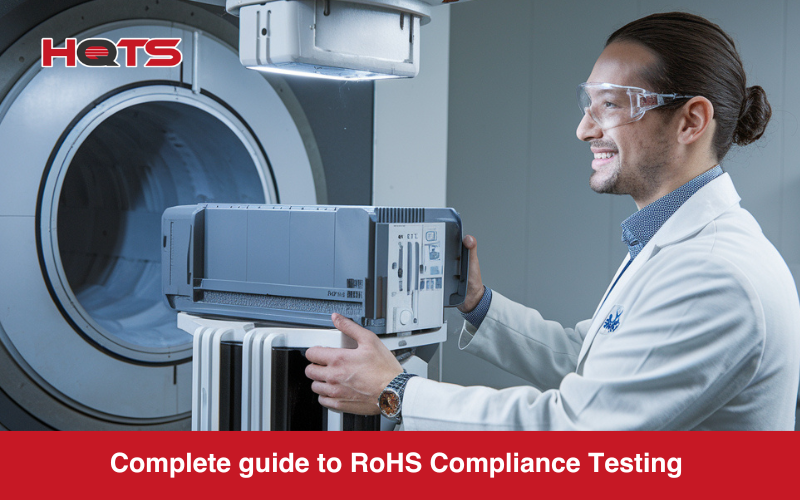What is RoHS testing?
RoHS stands for the Restriction on Hazardous Substances. It’s a rule made by the European Union (EU) to limit the use of certain harmful chemicals in things like electronics and electrical devices (EEE). These substances can be bad for the environment and people.
Companies that make these products have to test them to ensure they’re not using any of these toxic materials. Right now, there are 10 substances that are banned under RoHS, and manufacturers need to follow these rules to sell their products in the EU.
For a full breakdown of RoHS compliance check out our complete guide.

How is RoHS testing done?

So how is RoHS testing done? When testing products to see if they meet RoHS standards, you need to check for harmful chemicals. There are several ways to do this, but two of the most popular methods are XRF spectrometry and chromatography. Here’s how they work:
XRF Spectrometry (X-Ray Fluorescence)
This is one of the most popular and widely used methods for RoHS testing. It works by hitting the sample with high-energy X-rays, which causes the material to emit “secondary” or fluorescent X-rays. By analyzing these emissions, we can figure out what elements are in the material and in what concentrations.
For example, XRF can easily detect heavy metals like lead, which are restricted under RoHS. It’s especially useful for testing homogeneous materials (materials that are all the same throughout, like a solid plastic or metal). XRF is also one of the least expensive methods, making it a go-to choice for many manufacturers.
Chromatography
Chromatography is another important RoHS testing method, but it works differently. Instead of using X-rays, it separates the parts of a mixture chemically. This allows us to identify what substances are in the mixture and how much of each is present.
For RoHS testing, gas chromatography is used to detect substances like PBBs, PBDEs, and phthalates, which are all banned under RoHS. This method is especially helpful for analyzing materials that aren’t uniform or when we need to test for very specific chemicals in tiny amounts.
How Suppliers Can Get a RoHS CoC or DoC?
If you’re a supplier, getting a RoHS Certificate of Conformity (CoC) is all about showing that your products are safe and meet the rules by not using certain harmful materials like lead or mercury. To get one, you’ll need to have your product tested by a reliable lab to prove it’s compliant. A CoC is the official confirmation from the lab that your product passed the tests, while a Declaration of Conformity (DoC) is your statement as a supplier that your product meets the standards, based on those test results. In simple terms, the CoC is proof, and the DoC is your promise.
How to Ensure Your Products Are RoHS Compliant
To make sure your products follow RoHS rules, you need proper testing and documentation. HQTS can help with this. We have labs approved by CNAS (China National Accreditation Service) where we test your products for harmful substances. Our team gives you clear results, so you can be sure your products are compliant. With HQTS, you’ll know your products are safe and ready for the market, giving you and your customers peace of mind.
HQTS RoHS Testing Solutions
HQTS offers easy and reliable support to make sure your electronic and electrical equipment (EEE) products meet RoHS standards and are ready for the market. With our in-house labs, we can help you stay compliant with RoHS regulations, so your products can enter the EU smoothly without delays or expensive recalls.
We simplify the RoHS testing process with on-site CNAS accredited RoHS lab testing, detailed documentation reviews, and process audits. Our services cover a wide range of products, including household appliances, IT and communication devices, consumer electronics, lighting, electrical tools, toys, and more. Reach out to our team to learn how we can support you!




